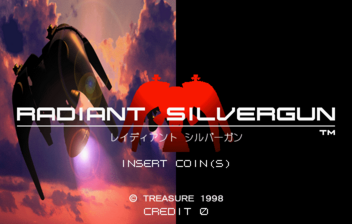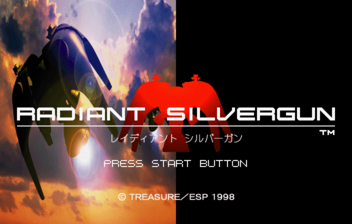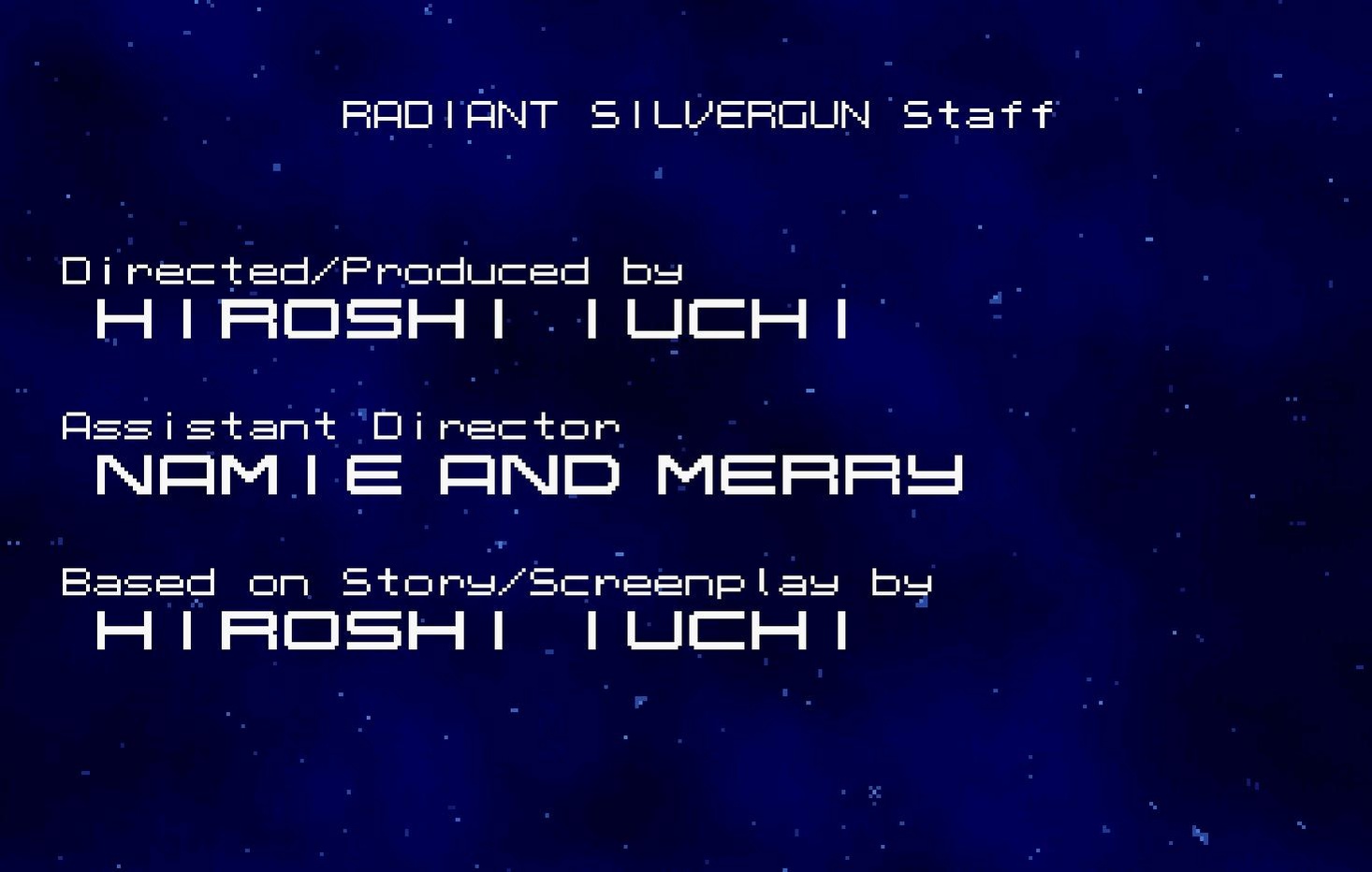Radiant Silvergun
From Sega Retro
| ||||||||||||||
| Radiant Silvergun | ||||||||||||||
|---|---|---|---|---|---|---|---|---|---|---|---|---|---|---|
| System(s): Sega Titan Video, Sega Saturn | ||||||||||||||
| Publisher: Treasure Entertainment Software Publishing | ||||||||||||||
| Developer: Treasure | ||||||||||||||
| Supporting companies: Gonzo | ||||||||||||||
| Sound driver: SCSP/CD-DA (18 tracks) | ||||||||||||||
| Genre: Shooting[1][2] | ||||||||||||||
| Number of players: 1-2 | ||||||||||||||
|
Radiant Silvergun (レイディアント シルバーガン) is a vertically scrolling shoot-'em-up video game, developed by Treasure. It was released in arcades on the Sega Titan Video (ST-V) platform in 1998, and subsequently ported to the very similar home console the Sega Saturn with added cutscenes by noted animation studio Gonzo. The game was not released outside of Japan. In 2011 it was released on Xbox Live Arcade internationally.
The game received a spiritual sequel in the form of the 2001 game Ikaruga. Sega Logistics Service announced it would end service on Radiant Silvergun arcade machines on March 31, 2017.[4][5]
Contents
Story
An octahedron-shaped artifact called the Stone-Like, along with a non-functioning robot, has been unearthed. Earth's secretary of defense, Chief Igarashi, orders the Stone-Like to be examined. Meanwhile, up in Earth's atmosphere, inside the spaceship Tetra, Commander Tengai issues Buster, Reana and Gai to test out the three new Silvergun prototype fighter crafts. Back on Earth, Igarashi relays information on the Stone-Like and the robot, claiming it has the serial number 00104, the exact same number of the robot aboard the Tetra, CREATOR 00104. Tengai cannot believe this be just a coincidence (partly due to Igarashi proving that it is, indeed the same robot), and has the three Silvergun pilots on standby. Suddenly, the Stone-Like starts to act up and destroys the facility containing it. As it overwhelms the Earth defense forces, the Stone-Like wipes out all life on Earth in a magnificent flash. Only the crew of the Tetra remain unharmed, as they were in satellite orbit. One year after the Stone-Like destroyed Earth, the Tetra, running low on supplies, makes its return to Earth.
The story is now told non-linearly, beginning with the third stage of the game, entitled Return. The Tetra flies back to Earth, and the three pilots, in their respective Silverguns, are sent out to investigate. Stage 2, Reminiscence, is actually a flashback sequence, where the Tetra and the Silverguns head to the Earth defense headquarters, where Chief Igarashi is, prior to the Stone-Like's attack. Knowing it's impossible to stop the Stone-Like, Igarashi has the Tetra and the Silverguns to make for satellite orbit, and evade the Stone-Like. The escape is successful, but the same cannot be said for Earth and its inhabitants.
Back in the present, the Stone-Like, now aware of the Tetra and Silverguns' presence, uses its power and commands its own manufactured weapons to destroy them. Stage 4, known as Evasion, now takes place. Seeing a need to know more about the Stone-Like, Tengai has Creator, the robot aboard the Tetra, to head for the Earth defense headquarters and gather information about it, while the Tetra and the Silverguns hold off the Stone-Like's forces. However, the Stone-Like sees through their plan and heads straight for the headquarters as well. Stage 5, Victim, begins, as two towering battleships lumber over the headquarters, intending to prevent Creator from succeeding its mission. The Silverguns hastily destroys the cruisers, but the Stone-Like appears and levels the headquarters. Just before the building collapses, Tengai pilots the Tetra and holds up the structure from falling, allowing Creator to board Reana's Silvergun to safety. Catching the Stone-Like off-guard, Gai goes on a suicidal run and attempts to destroy the artifact, but fails to do so, as his Silvergun vanishes upon contact with it. Tengai orders Buster and Reana to head for space, while he makes a last ditch effort and attempt to stall the Stone-Like, just as Gai did. With all seemingly lost, Buster persuades Reana to join him and try to destroy the Stone-Like. Before they head out into the space, Creator asks that they leave it one thing from them...
The Stone-Like, having located Buster and Reana, engages them in space combat, while briefly explaining that because of humanity's constant nature to war and destroy, it had to bring about the apocalypse. Stage 6, Origin, concludes with the Stone-Like, having been defeated, now transports the two Silverguns and its pilots back in time, to the year 100000 BC. Stage 1, Link, has the Stone-Like unleash its power in a cataclysmic explosion. As Buster and Reana make an attempt to escape the blast, they are swallowed up in the blinding light, seemingly destroyed. The ending concludes with Creator, 20 years into the future, having secluded itself inside an underground facility on Earth, now brimming with life again, creating a clone of Buster and Reana, from their strands of hair, the thing that he asked from both of them. The Stone-Like is now deactivated, its power exhausted from the last battle.
In its last moments before its energy fades, Creator explains that the Stone-Like is the guardian of Earth, and sees to it the advancement of the planet, its inhabitants and their way of living. If it deems that things must start over, the Stone-Like will destroy Earth and recreate it again, until humanity realize their nature and change before the Stone-Like delivers the consequences. Creator's purpose was always to ensure that mankind will survive, through their clones, and with these words, Creator stops functioning. As the story ends, the Buster and Reana clone start to wake from their cloning tubes.
It should be noted that the story of Radiant Silvergun is only available in the Saturn Mode of the Sega Saturn version of the game. Arcade Mode and the original arcade version of Radiant Silvergun do not include any cutscenes or dialog save for a slide show at the end of the game consisting of stills from the ending video.
Gameplay
Radiant Silvergun features a unique and innovative weapons system, with seven weapons available at any time. The player has three buttons to control the weapons; the weapon fired depends on the combination of buttons pressed. According to producer Hiroshi Iuchi, the main inspiration for the game's design was Image Fight, an arcade game by Irem from 1988[6].
Unlike in most other shoot-'em-ups, there are no power-ups to collect. All weapons are available from the start. Weapons can 'level up', however, becoming more powerful as the player uses them to score points. There are a selection of 7 weapons that can be used at any given time:
- Vulcan Cannon: Fires a stream of bullets from the front end of the craft. Shots become increasingly powerful and larger as it levels up.
- Homing Laser: Fires comparatively weak green lasers from two cannons that home in on targets. Shots become larger and more powerful as it levels up.
- Side bombs: Fires two explosive warheads at 60 degree angles from the craft. Shots become increasingly powerful as it levels up.
- Rear Vulcans: Fires a spread of vulcan bullets from the back of the craft, along with a one-bullet wide stream from the front. Range of rear-firing shots increases as it levels up.
- Lightning beams: Two tracking lasers swivel at acute angles in front of the craft. They will lock on to enemies and fire a stream of electricity that can pass through walls. Range increases as it levels up.
- Homing Missiles: Expands a circle of arrows from the craft. Anything inside the circle will be targeted with homing missiles. Range of the circle increases as it levels up.
- Radiant Sword: A polygonal sword that can deal heavy damage up close. As soon as the button is pressed it swings in a full circle around the craft, and will then trail in the opposite direction to which the craft is moving. It can be used to absorb pink bullets which fill a gauge at the top left of the screen. When this gauge is full, the next time the button is pressed a pair of massive polygonal swords will appear on both sides of the craft, and swing round before converging directly in front.
The game is designed so that there is almost always a 'right' weapon for any situation. The bosses in the game are designed so that they have multiple 'sections' which, if all destroyed before the 'core' of the boss, will award the players with point bonuses. Being able to apply the right weapons on any different boss is key to obtaining these bonuses. For example, a boss may have two sections located on either side of the screen. You could immediately go up to one and begin shooting it with a vulcan, or you could hover in the centre and hit both at the same time with the side bombs. This would increase your chance of obtaining the bonus before the time limit runs out and the boss self-destructs.
The game rewards players for "chaining" enemies of just one of three colors, red, blue, or yellow. Whenever the player kills three enemies that are of the same color, who can obtain a points bonus. This also facilitates faster upgrading of weapons.
In the arcade mode, the game's first level is stage 3. At the end of stage 3, the player can choose to continue at stage 2 or stage 4. Both stages lead to stage 5, then stage 6, and the finale at stage 1. This is true to the story's chronology; for example, the events of stage 2 occurred a year before stage 3. In the Saturn version, the player is forced to play all of the stages, starting at stage 3, to stage 2, then 4 through 6 and 1.
Production credits
Saturn version
- Directed/Produced by: Hiroshi Iuchi
- Assistant Director: Namie And Merry
- Based on Story/Screenplay by: Hiroshi Iuchi
- Tyrant Programer: Fukuryu
- Zako Enemies Program and Set by: 1998/Nami
- STV-11/SATURN-4/Boss Programmed: 2015/Nami
- BG,Demo,6 Bosses,Tool Programmed by: Atsutomo Nakagawa (133MHZ)
- Inu Program: Choko Monkey
- Object Design: Dad Oginon, Naokiman
- Object Design Rookie: E-Suzuki
- Face Window Graphic by: Kazuo Yasuda
- BG graphic: Hiroshi Iuchi 11
- Character Designed by: Han
- Music by: Hitoshi Sakimoto
- Sound Effects: S.Murata
- Story Board: Mahiro Maeda
- Director: Seiji Mizushima
- Art Director: Hiromasa Ogura
- Animation Director: Atsushi Hasebe, Takashi Tomioka
- Illustrator: Tsutomu Nishiyama, Shigeki Kuhara, Fujio Suzuki, Atsushi Hasebe, Tatsuhiko Tomioka, Yutaka Nakamura, Anime Toro Toro
- Animation Check: Kumiko Tanihara, Yukari Yamaura
- Animation: Kumiko Tanihara, Yukari Yamaura, Morihiko Yano, Mai Nakasato, Shingo Nishiyama, Okihito Hirose, Chiharu Haraguchi, Hiromi Furuya, Anime Toro Toro, D.R Movie, Daisaku Hirao, Takao Annen, Manabu Katabami
- Color Setting: Eriko Murata
- Digital Paint: Studio M.I., Yumeta Company, Tama Production, Telecom Animation, Visual Work Shop, Buyu, Reatrick, Takahashi Production, /T2 Studio
- Digital Retouch: Shin Inoie
- Back Grounds: Takesi Sato, Osamu Li, Production I.G, /Ogura Kohboh
- CGI: Susumu Fukushi, Naoko Seki
- Editor: Kengo Shigemura, Futoshi Keida
- Producer: Shouji Murahama, Shinji Nakashima
- Production manager: Youji Hori
- Production: Gonzo
- Director/Sound Design: Yota Turuoka
- Sound Effect: Jyuichi Tanaka
- Recording Engineer: Syouji Hata
- Sound Production: Rakuonsha
- Baster: Kenyu Horiuchi
- Reana: Tomoko Kawakami
- Guy: Nobutoshi Hayashi
- Creator: You Kitazawa
- Tengai: Takeshi Watabe
- Secretary Igarashi: Yosuke Akimoto
- Student A: Kenichi Sakaguchi
- Student B: Takehiro Murozono
- Operator 1: Mahiru Kondo
- Operator 2: Takako Honda, Fumihiko Goto
- Executive Coordinator: Youichi Miyaji
- Coordinator: Keitaro Numata
- Sales Staff: You Tsukagoshi, Yoshio Kaminishi
- Promotion: Hiroshi Ogasawara
- Receptionist: Haruko Hosaka
- Special Thanks: Koji Ohto, Akiyoshi Shinpo, Kaoru Uno
- Debug Cooperator: KJI, Shirotg, Waka, Kazuhiko Murakami
- Debug Dog: Merry
- Executive Producer: Masato Maegawa
- Presented by: Treasure
Magazine articles
- Main article: Radiant Silvergun/Magazine articles.
Promotional material
Physical scans
Sega Titan Video version
Saturn version
| Sega Retro Average | ||||||||||||||||||||||||||||||||||||||||||||||||||||||||||||||||||||||||||||||||||||
|---|---|---|---|---|---|---|---|---|---|---|---|---|---|---|---|---|---|---|---|---|---|---|---|---|---|---|---|---|---|---|---|---|---|---|---|---|---|---|---|---|---|---|---|---|---|---|---|---|---|---|---|---|---|---|---|---|---|---|---|---|---|---|---|---|---|---|---|---|---|---|---|---|---|---|---|---|---|---|---|---|---|---|---|---|
|
| 88 | |
|---|---|
| Based on 16 reviews | |
Technical information
- Main article: Radiant Silvergun/Technical information.
External links
References
- ↑ File:RadiantSilvergun Saturn JP Box Back.jpg
- ↑ 2.0 2.1 https://sega.jp/history/hard/segasaturn/software_l.html#tab04 (Wayback Machine: 2019-12-07 02:59)
- ↑ Sega Saturn Magazine, "1998-18 (1998-06-12)" (JP; 1998-05-29), page 74
- ↑ File:SegaProductsTerminationAnnouncement 2016-11 JP.pdf
- ↑ File:SegaProductsTerminationAnnouncement 2016-12.pdf
- ↑ http://www.emuxhaven.net/~silver/Hiroshi%20Iuchi%20Interview.html
- ↑ File:RadiantSilvergun_Saturn_JP_SSEnding.pdf
- ↑ Arcade, "December 1998" (UK; 1998-11-17), page 150
- ↑ Consoles +, "Septembre 1998" (FR; 1998-0x-xx), page 95
- ↑ Computer & Video Games, "September 1998" (UK; 1998-08-12), page 72
- ↑ Edge, "October 1998" (UK; 1998-09-08), page 95
- ↑ Famitsu, "1998-07-31" (JP; 1998-07-17), page 1
- ↑ Fun Generation, "10/98" (DE; 1998-09-09), page 97
- ↑ Gamers' Republic, "September 1998" (US; 1998-08-18), page 84
- ↑ Joypad, "Septembre 1998" (FR; 1998-xx-xx), page 74
- ↑ Mega Console, "Ottobre 1998" (IT; 1998-xx-xx), page 74
- ↑ Next Level, "Noviembre 1998" (AR; 1998-xx-xx), page 42
- ↑ Saturn Fan, "1998 No. 14" (JP; 1998-07-10), page 144
- ↑ Saturn Fan, "1998 No. 18" (JP; 1998-09-11), page 64
- ↑ Sega Magazin, "Oktober 1998" (DE; 1998-09-02), page 13
- ↑ Sega Saturn Magazine, "September 1998" (UK; 1998-08-12), page 68
- ↑ Sega Saturn Magazine, "1998-22 (1998-07-24,31)" (JP; 1998-07-10), page 209
- ↑ Sega Saturn Magazine, "Readers rating final data" (JP; 2000-03), page 10
| Radiant Silvergun | |
|---|---|
|
Main page | Comparisons | Hidden content | Magazine articles | Reception | Technical information
Music: Radiant Silvergun Soundtrack- (1998) | Radiant Silvergun Soundtrack+ (1998)
Demos: Radiant Silvergun Sample (1998) | |










